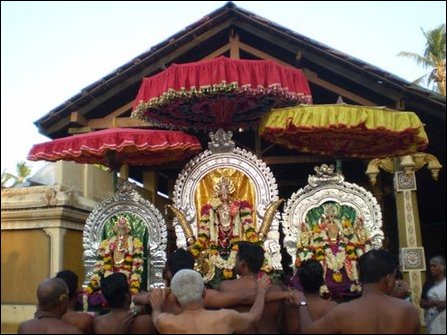Know the Etymology: 186
Place Name of the Day: Saturday, 05 February 2011
Thalaiyaa'li-veddai
தலையாளி வெட்டை
Talaiyāḷi-veṭṭaiThalai+aa'li+veddai
The open land of the deity Vairavar holding a head on his hand
| Veddai |
open land, vacant land (Eezham Tamil place names);= Veddaan-tharai: dry, hard ground without vegetation (Tamil, MTL, citing Jaffna dictionary); = Ve'li: open land (Tamil, MTL, citing Madurai dictionary); Vedda-ve'li: open plain (Tamil, Thirumoolar, 2591, DED 5475); 1. Ve'li: (verb) to be open, be vacant, empty; (noun) outside, open space, plain (Tamil, DED 5498); Vedi: = Ve'li (Tamil, Pingkalam, 1: 6); 2. Vedi: open space (Tamil, Thivaakaram, 11: 227); from (verb) to dawn (Tamil, DED 5475); Veddam: light (Tamil, DED 5475); Vedda: clear, plain (Tamil, DED 5475); 3. Veddi, Veddai: uselessness, worthlessness (Tamil, DED 5477); related to Ve'ru: empty (Tamil, DED 5513; Ve'rumai: emptiness (Tamil, DED 5513)
|
| Thalai |
Thalai: Head, top, end, tip, hair (Tamil, Dravidian Etymological Dictionary 3103)
|
| Aa'l |
Man, person (Tamil, DED 399); Aali: One who rules (Tamil, DED 5157); Aalvaar: The deity as supreme ruler (Tamil, DED 5157)
|
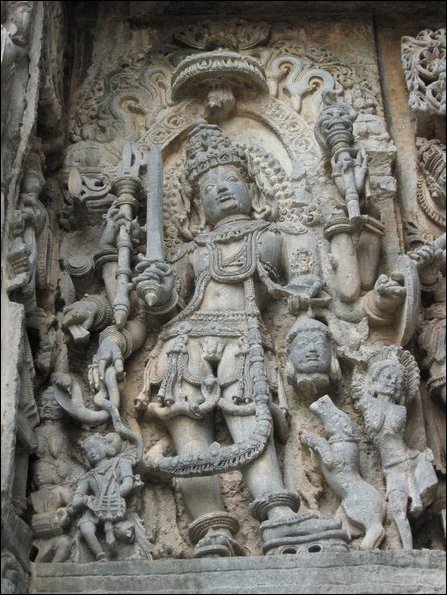
Bhairava (Vairavar), Halebidu, Karnataka. Note the dog licking blood from the head held in hand and Kaa'li dancing on its side [Image courtesy: Sajith. N., Picasa Web Albums]
The component Veddai in Eezham Tamil place names means an open land or a vacant land. It is usually a barren land, hard ground or flood plain with no vegetation or scanty vegetation.
The term corresponds to phrases such as Veddan-tharai, Vedda-ve'li etc., in Tamil, meaning the same as Veddai.
The etymology of Veddai could be explained through three Tamil/ Dravidian etyma: Ve'li/ Vedi meaning open space (DED 5498); Veddam meaning light and in that sense meaning open space (DED 5475) and Veddi/ Veddai meaning uselessness (DED 5477), related to the root Ve'ru (empty, DED 5513).
Veddai has the cognates, Ve'li, Veddi and Vedduvaan in Eezham Tamil place names.
* * *Thalaiyaali in Kokkuvil, Jaffna, got its name from the Thalaiyaali Vairavar temple located at the edge of an open stretch of land.
Until 1970s, Thalaiyaali was an open land with scrub jungle of wild trees such as wood apple, Naaval (Jampu), guava and custard apple on its fringes.
The open land, popularly called Thalaiyaali Veddai (expanse) stretched up to at least a kilometre between Vannaarpannai and Kokkuvil.
The stretch used to get heavily flooded during rainy season and in summer it was a favourite location for the kite flyers of the nearby villages. Humming kites of large sizes tied on palmyra palms used to hover above the stretch for days together in the months of June-July.
Thalaiyaali-vairavar has already become Gnaana-vairavar by that time. But the belief that he will cause stiff neck, if not worshipped while passing through the stretch, was still there.
The Thalaiyaali expanse is a dense housing area today.
The meaning in which the deity used to be revered by the folk, against the backdrop of the landscape, is also lost today.
* * *The place name Thalaiyaali is an example for toponyms coming from temples or from a deity considered to be presiding over a landscape.
Thalaiyaali is a form of the deity Vairavar.
The cult of Vairavar (Bhairavaa) is very popular, especially in the folk practice of Saivism among Eezham Tamils.
Thousands of temples and shrines dedicated to Vairavar could be found even in remote areas of the Tamil country in the island.
Besides, in thousands of other locations, a simple trident placed under a tree also marks the presence of the deity.
Even though the symbol of trident of prehistoric origins represents many folk deities, both male and female, in the Eezham Tamil context it largely represents Vairavar.

Tridents marking the cult of Vairavar and other folk deities under a Maruthu (Terminalia arjuna) tree, near Naakar Koyil, Jaffna [Image courtesy, Early Settlements in Jaffna: An Archaeological Survey, p 204]
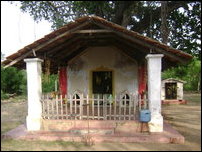
A shrine for Vairavar under a banyan tree. Narasinga-vairavar shrine (Vairavar who took the form of Sarabha bird to subdue the ego of Vishnu as Narasinga), Kozhumpuththurai, Jaffna [Image courtesy: Umapathy, Panoramio, Google Earth]
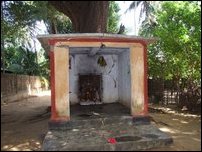
A home shrine for Vairavar under a tree at Kokkuvil [Image courtesy: Dushyanthini Kanapathipillai, humanityashore.com]
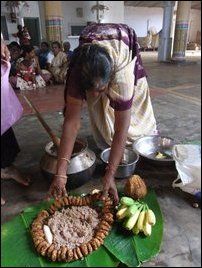
A garland of Vadai made of black gram is a favourite offer to Vairavar. Koanaavalai Vairavar temple, Thirunelvely, Jaffna [Image courtesy, Dushyanthini Kanapathipillai, humanitiyahore.com]. But there are also temples like the Kavanaavaththai Vairavar, near Keerimalai, Jaffna, where animal sacrifices used to be the favourite offer.
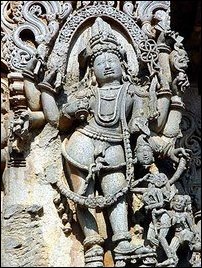
Bhairawa, Halebidu, Karnataka. Note Kaa'li licking blood from the head held in hand [Image courtesy: www.art-and-archaeology.com]
Where ever sacred trees such as Naaval (Jumbu), Puli (Tamarind), Maruthu (Terminalia arjuna), Iluppai (Mahul), Aal (Banyan), Aracu (Bo) etc are found, the trident placed under it represents the deity, and on many occasions the deity is identified by that tree, such as Puliyadi Vairavar, Arasadi Vairavar etc.
It is common to see the worship of Vairavar in the form of a trident inside residential premises too, mostly if a sacred tree is found there.
The popularity of the cult of Vairavar is a significant feature that differentiates the folk religion of Eezham Tamils from that of the Tamils of Tamil Nadu.
The Vairavar cult is considered to be an element that has come through non-Brahmanic Pasupata Saivism.
It is also said that during the times of the Portuguese and Dutch colonial rule, when temples were destroyed and Saiva worship was prohibited, people started worshipping tridents placed under trees inside residential premises and thats how the Vairavar cult became popular among Eezham Tamils.
Whatever the case may be, the cult of Vairavar as it is practiced among Eezham Tamils, is closely identified with the awe and mysteries associated with nature. Cremation grounds, sprawling trees evoking awe and open stretches of lonely landscape are where the presence of Vairavar is invariably marked in the folk religious practice of Eezham Tamils.
When people passing through dont pay homage to Vairavar in those lonely places, he may cause stiff neck is a general belief.
In the Agamic temples, Vairavar as guardian deity, iconographically depicted with his vehicle, dog, has a shrine next to the entrance facing the main deity.
In sculptures of Agamic traditions, Vairavar and Kaali were depicted as manifestations of Siva and Parvati fulfilling certain specific tasks. When a demon had to be killed without spilling blood, Vairavar performed it while Kaali and the dog drank the blood without allowing it to be spilled.
Eight Agamic temples (Adda-veeradda-temples), officiated by Sivaachchaariyaas of Agamic descent are recognized in Tamil Nadu for the Bhairava forms of Siva.
A temple of much historical antiquity, Chaddainaatha Swamy temple (the form of Bhairava Siva attired in the skin of Brahma (Chaddai) at Nalloor, Jaffna, belongs to the above tradition.
Several forms of Vairavar such as Chadai-vairavar, Channaasi-vairavar, Mayinthi-vairavar, Chudalai-vairavar, Viruma-vairavar (Brahma < Piruma > Viruma) etc are recognized in the folk cults of Eezham Tamils.
Whenever the folk shrines are Brhamnized, the identity of the folk forms usually become Gnaana-vairavar (the Vairavar of enlightenment).
Thalayaali-vairavar is a form in which the Vairavar holds the head of Brahma in his hand.
In mythology it is said that Brahma who earlier had five heads like that of Siva thought that he was equal to Siva. Vairavar nipped off his fifth head at the top of the other four to teach a lesson (salvation comes by the subdue of ego is the philosophy of Saiva Siddhanta).
Kantha-puraanam, a religious literature much revered by Eezham Tamils, narrates the mythology in the following verse:
பரமனை மதித்திடாப் பங்கயாசனன்
ஒருதலை கிள்ளியே ஒழிந்த வானவர்
குருதியும் அகந்தையும் கொண்டு தண்டமும்
புரிதரு வடுகனைப் போற்றி செய்குவாம்
Paramanai mathiththidaap pangkayaasanan
Oruthalai killiyea ozhintha vaanavar
Kuruthiyum akanthaiyum kondu thandamum
Puritharu vadukanaip poatti cheykuvaam
Let us praise the Vadukan (Vairavar), who nipped off one head of the Pangkayaasanan (Brahma) disrespectful to Shiva, and who punishes the rest of the celestial beings by taking their blood and pride.
* * *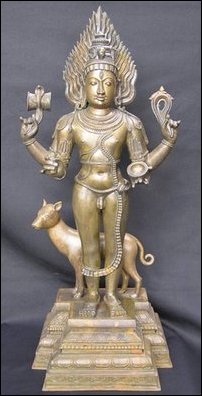
A commercial piece of Vairavar image made in the traditional way, using the five-metal-alloy and lost wax technique [Image courtesy: store.bronzecreativestore.com]
Another explanation, Thalai-alam: plain land is also possible for the place name. But it seems the more appropriate explanation for the place name comes from the title Thalaiyaali for the deity Vairavar located in that place.
Note that there are other place names such as Chadaiyaali in Kaarainakar and Theavaraiyaali in Vathiri, Vadamaraadchi, which are also associated with Vairavar temples in those places.
Also note that the phrase Karung-kuthiraiyaali (one who rides a black horse) is a reference to Vairavar (Choodaamani Lexicon 1:35). In usage, the Aali suffix seems to be having a special association with the deity Vairavar.
* * *Thalaiyaali is a part of Kokkuvil in the Nalloor division of Jaffna district.
* * *Some related place names:Chadaiyaali: Chadai-aali: (The place of) the deity Chadai-Vairavar of matted locks. This is a locality in the Kaarainakar Island in the Jaffna district. An old shrine of the Chadaiyaali Vairavar and a constructed pond now dilapidated are located here on a sandy stretch that opens into a vast grassland plains (Tharavai) a little away.
Theavaraiyaali: Theavarai-aali: (The place of) the one who rules the celestials (Vairavar); Vathiri, Vadamaraadchi Southwest (Karaveddi) division, Jaffna district. Thevarai-aali: The one who rules the celestials. This is a title attributed to Vairavar (note the Kanthapuraanam verse cited above). The foremost temple of this place is dedicated to Vairavar, who is known as Peri-Vairavar. Peri < Pari: Horse. Note that the phrase Karung-kuthiraiyaali (the one who rides a black horse) is a name for Vairavar, according to Choodaamani Lexicon. In the past the temple was known for animal sacrifices. Theavaraiyaali, having other folk temples too dedicated to deities like Panikkar and Kaaththavarayar that have come from clan/ ancestor cults, is a place mainly inhabited by folk of the lower echelons of the society. The strong folk religious traditions of the people of the place made them to resist to religious conversions. In the 19th century and early 20th century, when education meant religious conversion in the missionary schools and equal education was denied to the lower echelons of the society in the native schools, a leader of the people of this place, Kaa. Chooran, a follower of Arumuka Navalar, built a school for the children of this place to have education in Saiva environment. The school is known today as Theavariyaali Hindu College.
* * *Veddai:Karukku-veddai: The thorny open land; Ea'raavoorppattu division, Batticaloa district. Karukku, Karu: thorn, barb, spike, teeth of a saw or sickle, jagged edge of palmyra leaf-stalk (Tamil, DED 1265); Karu and Karukku meaning thorn and barb respectively are of common usage in Batticaloa Tamil (V.C. Kanthaiya, 1964, P 122)
Vathira-veddai: The open land of Zizyphus jujuba trees; Ea'raavoor-pattu division, Batticaloa district. Vathari: Zizyphus jujuba (Tamil, Thivaakaram, 4: 60); Badara: (Sanskrit, CDIAL 9125); Debara: (Sinhala)
Aandaiyan-veddai: or Aanthayan-veddai: Koara'laippattu division, Batticaloa district
Aththikkaadu-veddai: Koara'laippattu division, Batticaloa district
Aaththu-veddai: Koaralaippattu division, Batticaloa district
Kalladi-veddai: Koaralaippattu division, Batticaloa district
Thoappi'raveddai: Koaralaippattu division, Batticaloa district
Azhakar-veddai: Ea'raavoorppattu division, Batticaloa district
Aalaiyadi-veddai: Ea'raavoorppattu division, Batticaloa district
Kagnchan-veddai: Ea'ravoorppattu division, Batticaloa district
Kanthappar-veddai: Ea'raavoorppattu division, Batticaloa district
Kudaa-veddai: Ea'raavoorppattu division, Batticaloa district
Peru-veddai: Ea'raavoorppattu division, Batticaloa district
Thava'nai-veddai: Ea'raavoorppattu division, Batticaloa district
Vathira-veddai: Ea'raavoorppattu division, Batticaloa district
Aattangkarai-veddai: Ea'raavoor Town division, Batticaloa district
Jifri Thaika-veddai: Ea'raavoor Town division, Batticaloa district
Kaaddumaavadi-veddai: Ea'raavoor Town division, Batticaloa district
Kaadduppa'l'li-veddai: Ea'raavoor Town division, Batticaloa district
Maavadi-veddai: Ea'raavoor Town division, Batticaloa district
Moongkiladi-veddai: Ea'raavoor Town division, Batticaloa district
Muhaanthiram-veddai: Ea'raavoor Town division, Batticaloa district
Munaiya-va'lavu-veddai: Ea'raavoor Town division, Batticaloa district
Oaddup-pa'l'li-veddai: Ea'raavoor Town division, Batticaloa district
Pe'n-chanthai-veddai: Ea'raavoor Town division, Batticaloa district
Pu'liyadi-veddai: Ea'raavoor Town division, Batticaloa district
Chanthai-veddai: Ea'raavoor Town division, Batticaloa district
Saviya-pa'l'li-veddai: Ea'raavoor Town division, Batticaloa district
Thaikaavadi-veddai: Ea'raavoor Town division, Batticaloa district
Packiran-veddai: Ki'n'niyaa division, Trincomalee district
Chanthana-veddai: Moothoor division, Trincomalee district
Thoddaach churungki Puthuk-kaadu Veddai: The open land of the new paddy fields in the locality of Thoddaach-churungki (sensitive plant, Mimosa pudica) plants; Sammaanthu'rai division, Ampaa'rai district (TN news, 18.07.15)
Varampu-va'laintha-veddai: probably, Varampu-va'laiththa-veddai: The open land encompassed by a bund; Sammaanthu'rai division, Ampaa'rai district (TN news, 18.07.15)
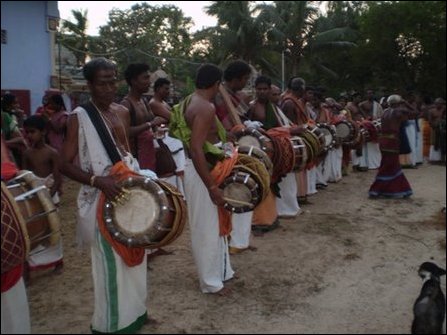
A festival at Thalaiyaali Vairavar temple in recent times [Image courtesy: www.sabapathy.co.uk]
Previous columns:















